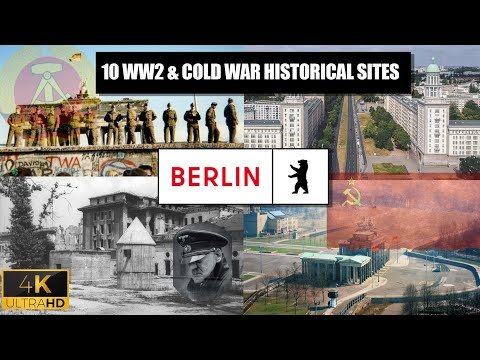🧱 Berlin Wall Tours: Cold War History 🚧🌍

The Berlin Wall has been one of the most iconic symbols of the Cold War era. It divided Berlin into East and West for almost three decades, separating families, friends, and communities. Today, the wall is a distant memory, but its legacy can still be felt in the city of Berlin. If you're interested in learning more about this important historical period, taking a Berlin Wall tour might be the perfect way to do it. These tours take you through the city to see the remnants of the wall and other significant Cold War landmarks, providing a fascinating insight into a pivotal moment in world history. In this article, we'll explore what you can expect from a Berlin Wall tour and why it's a must-do experience for anyone interested in Cold War history.
What did the Berlin Wall do to the Cold War
The Berlin Wall, which was constructed on August 13, 1961, became a symbol of the Cold War and had a significant impact on the global political landscape. The wall was a physical barrier that separated West Berlin from East Berlin and its surrounding areas. The construction of the wall had a profound effect on the Cold War, and its fall in 1989 marked a significant turning point in world history.
 🏰 Potsdam Day Trips: Palaces and Gardens 🏰🌸
🏰 Potsdam Day Trips: Palaces and Gardens 🏰🌸The Berlin Wall intensified the Cold War by increasing tensions between the United States and the Soviet Union. The wall was a clear indication of the ideological divide between the communist East and the capitalist West. The United States saw the wall as a symbol of Soviet aggression, while the Soviet Union saw the wall as a necessary measure to protect its interests.
The construction of the wall also led to a new phase of the arms race, as both sides tried to outdo each other in terms of military might. The United States, under President John F. Kennedy, responded to the construction of the wall by increasing military spending and deploying troops to West Germany.
The Berlin Wall was a catalyst for change, as it highlighted the stark differences between the two sides. The wall became a rallying point for those who opposed communism and Soviet domination. The fall of the wall in 1989 marked the end of the Cold War and the beginning of a new era of global relations. The fall of the wall also led to the reunification of Germany and the end of the communist governments in Eastern Europe.
The Berlin Wall also had a significant impact on the lives of ordinary people. Families were separated, and many East Germans were prevented from visiting their relatives in the West. The wall also prevented East Germans from fleeing to the West, and many were killed trying to cross it.
 🏰 Rothenburg Tours: Medieval Time Travel 🏰⏳
🏰 Rothenburg Tours: Medieval Time Travel 🏰⏳The Berlin Wall was a symbol of oppression, and its fall marked a victory for democracy and individual freedom. The fall of the wall was a momentous event that showed that change was possible, and that people could stand up against tyranny and oppression.
In conclusion, the Berlin Wall had a significant impact on the Cold War. It intensified tensions between the United States and the Soviet Union, led to a new phase of the arms race, and highlighted the differences between the two sides. However, the wall also became a catalyst for change, and its fall marked the end of the Cold War and the beginning of a new era of global relations. The fall of the wall was a victory for democracy and individual freedom, and it showed that change was possible.
What is the history of the Berlin Wall
The Berlin Wall, also known as the "Wall of Shame," was a physical barrier that divided the German city of Berlin from 1961 to 1989.
 🍺 Oktoberfest Tours: Beer Festival Fun 🍻🎉
🍺 Oktoberfest Tours: Beer Festival Fun 🍻🎉Construction: The construction of the wall began on August 13, 1961, by the German Democratic Republic (GDR) in an effort to prevent East Germans from fleeing to West Germany. The wall was made of concrete and barbed wire and stretched for more than 100 miles.
Dividing Families: The wall divided families and friends, separating them from one another for decades. The East German government strictly controlled access to the wall, and anyone caught trying to cross it was subject to imprisonment or even death.
Symbol of the Cold War: The Berlin Wall became a symbol of the Cold War and the struggle between the capitalist West and the communist East. It was a physical manifestation of the ideological divide that existed in Europe at the time.
Fall of the Wall: On November 9, 1989, the East German government announced that it would allow its citizens to travel to West Germany. Thousands of people flooded the streets, and the wall was breached as people climbed over it and began to dismantle it. The fall of the Berlin Wall marked the end of the Cold War and the reunification of Germany.
 🏰 Neuschwanstein & Linderhof: Fairy Tale Castles 🏰🧚
🏰 Neuschwanstein & Linderhof: Fairy Tale Castles 🏰🧚Legacy: Today, the Berlin Wall is a powerful symbol of the human desire for freedom and the struggle against oppression. Parts of the wall still stand as a reminder of the division that once existed in the city, and there are numerous museums and memorials dedicated to its history.
In conclusion, the Berlin Wall was a physical manifestation of the ideological divide that existed in Europe during the Cold War. Its construction divided families and friends and became a symbol of oppression. However, its fall in 1989 marked the end of the Cold War and the beginning of a new era of freedom and democracy in Europe.
Thank you for joining us on this journey through the history of the Berlin Wall. From its construction to its fall, we hope you gained a deeper understanding of the impact it had on Germany and the world.
By taking a Berlin Wall tour, you can witness firsthand the remnants of this historic barrier and learn about the stories of those who lived through it. It's a powerful and unforgettable experience.
We encourage you to visit Berlin and take a tour to discover the city's rich Cold War history. It's a lesson in resilience, hope, and unity that should never be forgotten.
Goodbye and safe travels!
If you want to discover other articles similar to 🧱 Berlin Wall Tours: Cold War History 🚧🌍 you can visit the category Germany.
Leave a Reply

¡More Global Tours!